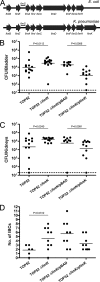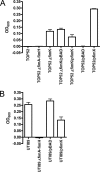Utilization of an intracellular bacterial community pathway in Klebsiella pneumoniae urinary tract infection and the effects of FimK on type 1 pilus expression
- PMID: 18411285
- PMCID: PMC2446714
- DOI: 10.1128/IAI.00090-08
Utilization of an intracellular bacterial community pathway in Klebsiella pneumoniae urinary tract infection and the effects of FimK on type 1 pilus expression
Abstract
Klebsiella pneumoniae is an important cause of urinary tract infection (UTI), but little is known about its pathogenesis in vivo. The pathogenesis of the K. pneumoniae cystitis isolate TOP52 was compared to that of the uropathogenic Escherichia coli (UPEC) isolate UTI89 in a murine cystitis model. Bladder and kidney titers of TOP52 were lower than those of UTI89 at early time points but similar at later time points. TOP52, like UTI89, formed biofilm-like intracellular bacterial communities (IBCs) within the murine bladder, albeit at significantly lower levels than UTI89. Additionally, filamentation of TOP52 was observed, a process critical for UTI89 evasion of neutrophil phagocytosis and persistence in the bladder. Thus, the IBC pathway is not specific to UPEC alone. We investigated if differences in type 1 pilus expression may explain TOP52's early defect in vivo. The type 1 pilus operon is controlled by recombinase-mediated (fimE, fimB, and fimX) phase variation of an invertible promoter element. We found that K. pneumoniae carries an extra gene of unknown function at the 3' end of its type 1 operon, fimK, and the genome lacks the recombinase fimX. A deletion mutant of fimK was constructed, and TOP52 Delta fimK had higher titers and formed more IBCs in the murine cystitis model than wild type. The loss of fimK or expression of E. coli fimX from a plasmid in TOP52 resulted in a larger phase-ON population and higher expression levels of type 1 pili and gave TOP52 the ability to form type 1-dependent biofilms. Complementation with pfimK decreased type 1 pilus expression and biofilm formation of TOP52 Delta fimK and decreased UTI89 biofilm formation. Thus, K. pneumoniae appears programmed for minimal expression of type 1 pili, which may explain, in part, why K. pneumoniae is a less prevalent etiologic agent of UTI than UPEC.
Figures






Similar articles
-
Molecular variations in Klebsiella pneumoniae and Escherichia coli FimH affect function and pathogenesis in the urinary tract.Infect Immun. 2008 Jul;76(7):3346-56. doi: 10.1128/IAI.00340-08. Epub 2008 May 12. Infect Immun. 2008. PMID: 18474655 Free PMC article.
-
Conserved FimK Truncation Coincides with Increased Expression of Type 3 Fimbriae and Cultured Bladder Epithelial Cell Association in Klebsiella quasipneumoniae.J Bacteriol. 2022 Sep 20;204(9):e0017222. doi: 10.1128/jb.00172-22. Epub 2022 Aug 25. J Bacteriol. 2022. PMID: 36005809 Free PMC article.
-
Maturation of intracellular Escherichia coli communities requires SurA.Infect Immun. 2006 Aug;74(8):4793-800. doi: 10.1128/IAI.00355-06. Infect Immun. 2006. PMID: 16861667 Free PMC article.
-
The Remarkable Biomechanical Properties of the Type 1 Chaperone-Usher Pilus: A Structural and Molecular Perspective.Microbiol Spectr. 2019 Jan;7(1):10.1128/microbiolspec.psib-0010-2018. doi: 10.1128/microbiolspec.PSIB-0010-2018. Microbiol Spectr. 2019. PMID: 30681068 Free PMC article. Review.
-
Klebsiella pneumoniae and type 3 fimbriae: nosocomial infection, regulation and biofilm formation.Future Microbiol. 2012 Aug;7(8):991-1002. doi: 10.2217/fmb.12.74. Future Microbiol. 2012. PMID: 22913357 Review.
Cited by
-
Recurrent Urinary Tract Infection: A Mystery in Search of Better Model Systems.Front Cell Infect Microbiol. 2021 May 26;11:691210. doi: 10.3389/fcimb.2021.691210. eCollection 2021. Front Cell Infect Microbiol. 2021. PMID: 34123879 Free PMC article. Review.
-
Urinary Tract Infections Caused by K. pneumoniae in Kidney Transplant Recipients - Epidemiology, Virulence and Antibiotic Resistance.Front Cell Infect Microbiol. 2022 Apr 21;12:861374. doi: 10.3389/fcimb.2022.861374. eCollection 2022. Front Cell Infect Microbiol. 2022. PMID: 35531341 Free PMC article. Review.
-
Options and Limitations in Clinical Investigation of Bacterial Biofilms.Clin Microbiol Rev. 2018 Apr 4;31(3):e00084-16. doi: 10.1128/CMR.00084-16. Print 2018 Jul. Clin Microbiol Rev. 2018. PMID: 29618576 Free PMC article. Review.
-
Sex Differences in Population Dynamics during Formation of Kidney Bacterial Communities by Uropathogenic Escherichia coli.Infect Immun. 2021 Mar 17;89(4):e00716-20. doi: 10.1128/IAI.00716-20. Print 2021 Mar 17. Infect Immun. 2021. PMID: 33468577 Free PMC article.
-
Conformational ensembles in Klebsiella pneumoniae FimH impact uropathogenesis.Proc Natl Acad Sci U S A. 2024 Sep 24;121(39):e2409655121. doi: 10.1073/pnas.2409655121. Epub 2024 Sep 17. Proc Natl Acad Sci U S A. 2024. PMID: 39288182 Free PMC article.
References
-
- Anderson, G. G., J. J. Palermo, J. D. Schilling, R. Roth, J. Heuser, and S. J. Hultgren. 2003. Intracellular bacterial biofilm-like pods in urinary tract infections. Science 301105-107. - PubMed
-
- Bran, J. L., M. E. Levison, and D. Kaye. 1972. Entrance of bacteria into the female urinary bladder. N. Engl. J. Med. 286626-629. - PubMed
Publication types
MeSH terms
Substances
Associated data
- Actions
Grants and funding
LinkOut - more resources
Full Text Sources
Medical
Molecular Biology Databases
Miscellaneous

